Outsourcing matrix
You are still doing something that other people do better? Then you are dead! Your mummy will long serve as a training aid in business schools …
Kiell Nordstrom
The outsourcing subject that address in this paper does not require the knowledge of various management schools, some complicated methodological approaches in the organization of management, and at the same time it is important and problematic today. The problem is that in Russia, similar to Ukraine, entrepreneurs do not want to share their business. Our businesspeople are afraid of cooperation and they strive to do everything on their own, earning a maximum amount of money. All that is good and normal until the company is in a developing market which is not filled and divided, until nobody can assess its performance or compare to the performance of a competitor. Until the competition is not intense this "same meadow" or a peculiar collective farm approach is very fruitful. By analogy with war affairs, while hostilities are on, some stringent centralized management is required where commander-in-chief is in control of everything. However, when competition appears, or, in military terms, the need to develop the seized terrain, this stringent centralized management system is no longer effective, as at each particular site, some particular problems are to be solved and some special approaches are needed. At this stage, local flexibility is called for rather than harsh discipline and precise command execution are called for.
The definition of outsourcing can be found in any economic dictionary. Moreover a definition of their own is virtually given by all management gurus. Despite the fact that this English word is not always understandable, outsourcing is an understandable thing. In simple words, outsourcing is handing over part of the work, or a particular functions or some contract activities to a company or people specializing in the area concerned. In terms of business, the process is like that. Some strategically important activities remain with the company, and what is not strategically important is handed over to somebody for use or to competitors.
Outsourcing gambit
Considering competition markets, all the management gurus speak about much the same. When it comes to strategies and directions of company development, the executives are to understand what their organizations are not doing rather than what they are doing. It is not until that understanding comes, the company can outsource something. In other words, everybody should do his business, other things are outsourced What does one need outsourcing for? Reason №1. All companies with their growth accumulate technologies, functions and competences. The focus of the administration should be on the key activities, i.e., those which are our specialty. The company is not to be engaged in any other activities!
We imply that the administration is to focus on the man and basic activity. Strangely as it may appear, all other things are to be done by professionals. Actually, any person uses outsourcing in his/her everyday life. The examples are handy. A master class or training is conducted in a room, which belongs to somebody. Somebody prepares the class room for a class and tidies it up after the event. There is electricity in the room, electric power sources, a coffee machine, etc. Each of us constantly interacts with the environment, including professional environment. It is not profitable to us to generate electric power. It is much easier to take it from an output receptacle. It does not matter who generates the electric power. It is done professionals. This is also outsourcing.
There are two approaches to outsourcing. Approach 1: the company sends some of its activities to the market so that they would earn money on their own. Approach 2: the company discontinues some of its activities and buys from other companies the needed products that it previously manufactured itself. Let us consider the above approaches in more detail.
Why put to the market some of the activities, some of its divisions or assets ? Let us address a situation whereby some unit is part of the company. When assessing it, the so-called transfer pricing is used. This implies that that some synthetic prices are synthetically referred to the unit. To understand the economy of such a unit is impossible. There is financial control of the unit itself by the company, but that control does not convey any actual information. Financiers live in an unrealistic world of plan-accounting prices that do not reflect the actual economy of the enterprise. Any big company with non-core business invariably employs transfer pricing, which organizes the economy of the company as a whole. It is possible to understand this economy but to determine what divisions contribute to the common results and which, conversely are only responsible for damage is impossible. Normally, all auxiliary operations are some resource base in order to ensure the profitability of the system a a whole. But even in case the financiers estimate the unit’s expenditure truly adequately, the accounting system applied (accountancy and managerial), based on the Soviet accounting school does not permit estimating the parameters of unit activity.
I shall supply n example. In one famous company there are a number of territorial divisions, but the administration, as usual, is headquartered in Moscow, and the "official" office is at the registration site – in a close an a very small city N, which the administration regards as an "N branch". The Moscow administration takes the decision of improving the head office — to install a fountain in front of the entrance, the funds being is available. Thus, a fountain is installed, which can, according to the Moscow administrators, operate at a temperature down to -30°С. Clearly, the fountain contains some special solution but not the water, and its operation costs a large amount of money, but nobody else has a fountain like that. According to the tradition and regulations of Russian accounting, the costs of the construction and maintenance of the fountain were posted to the "N branch", and the indices of its activity were the lowest of the low. And before that, the "N branch" earned enough money and yielded "profit". After two years, the Moscow administration starts blame storming, trying to find out why we earn no money in the city of N. The fountain is expensive but so what? You are to earn as much as everybody in the company! A proposal to post corporate expenses not territorially by according to the site where the decisions is made – i.e,, the one who made the decision on the spending is to be posted those costs to. shocked the Muscovites. I say Muscovites only conventionally as none of them was born in Moscow. Clearly, the proposal was not accepted.
Accordingly, if you put such a unit to the market, it is the market that starts to determined directly if you work efficiently or you do not . And the unit management decides if they need the fountain or for that money it would be best to have a gold toilet bowl installed in the VIP toilet and whether there is money at all available on such superfluities?
Everybody should do his business. The rest should be outsourced
The next characteristic point is the resistance of management to outsourcing. The struggle for the social and professional status of the manager is a main component of the management motivation. The main attribute of the status is the volume of controlled resources. Accordingly, the manager working in a company is aware that a certain area of activity , the assets and subordinates are always “in his pocket". And it is not necessary that he should have a high salary. The most important thing is his status, which is a guarantee of future prospects. As they say, "the more assets and people, the bigger is the boss". If one imagines that the unit of such a manager becomes an independent player at the market, the manager changes the motivation and the value system. Assets do not fall from the sky – one has to become far-seeing and flexible and earn the money independently t the market. The flexibility of small enterprises is determined by exactly such characteristics: they do not struggle for gaining greater control as do big companies, but rather for earning more.
In any more or less big company, the procedures of regulation, distribution of the functions, setting the tasks, granting authority take much time. From personal experience I can say that in modern Russian enterprises from 32 to 80% of the employees are functional drifters who do not know what to do but put papers from the left-hand side of the desk to the right-hand side and vice versa. Within the company prescribed problems prevail, which are assigned from above and oriented to the main business, while the work in auxiliary divisions is a sign of a second-rate specialist. All the employees of a company are slaves of technology and protocols and production is above all.
By contrast, in case of a market approach, the company puts some division beyond its boundaries, regarding it not s a center of expenditure but rather as a center of profits and investments. This is an important point. Very often the financiers of multi-branch companies, the companies engaged in various activities attempt distinguish each activity direction as a particular accounting center, estimating its profit separately. This is crazy. Profit is invariably concentrated at a single place — in the center of the company, where all expenses and profits are concentrated. Hence, as soon as disintegration of the company occurs, and you put something to the market, the company acquires a new center of profit and investments. It is not until that stage that you can actually see if the company is gaining something on it.
Why №2. Economy is changing. The service sector is increasing rapidly. The epoch of professional services comes (on the basis of competence and ideas from big companies). If you consider a very abstract composition of the markets, the composition of demand and supply, you can see that at the beginning of last century, the main branches of economy were raw materials. It is only one-type products and services that were produced. An what is happening nowadays? The same basic raw-material industries remain, with which no one would compete seriously. Products become still more one-type: we buy an automobile of the same class manufactured in Germany, China, Japan or the United States, and within two months perspire the same plastic odor and the cars have the same running qualities. Possibly, there is some difference in design. Moreover, the services become of the same type. However, nowadays companies start speaking about purchasing impressions. Like mushrooms after rain there emerge various entertainment centers, text-books are published and workshops and master classes are conducted, etc. The impression industry has been growing at a great rate. It is thought that the materials sector will remain as well as products and services, but the bulk of commodity exchange will be accounted for by impressions. It this statement is true, one should first focus on selling services and impressions. In this case, it is necessary to use the competences of big companies. Those should be disintegrated into individual elements which provide professional services.
Have you good financiers, technologists or IT specialists? Send them to the market. Let them confirm their competence in a fair competition. All the talk that their work is unique is fake. Let them try to prove their uniqueness and high qualification at an open market, which will undoubtedly assess them. Only 2-3% of natural resources are unique, the rest have been long known and can be reproduced. Тhose entrepreneurs who believe that their clerks are unique and indispensable are merely losing their money. They overpay them and lose their money. But in the very rare case of the actual availability of those unique features they do not use the and thus again lose their money.
Why №3. Modern economics is not the economics of Adam Smith and Karl Marx, which was known one hundred years ago. Whereas one hundred years ago economics was based on the production of material values, simple-type products, harsh competition and optimized production, nowadays, the basis of competitiveness is the management of knowledge, production of services, customization of goods, flexibility and urgency of management. In addition to the manufacture of their main product, whether, automobile, hardware, or electric power, any western company renders services to their customers. The concept of consumer profit is used, which led, say, General Electric to quite unexpected marvelous market prospects.
A soft competition emerged whereby there appeared a possibility of choosing suppliers who can work for various customers. In fact, General Motors can manufacture spare parts for Ford – formerly a similar situation would not have been possible. Today competition is shifted to the area of greater cooperation. The above has a direct bearing on outsourcing: what you are doing badly should be done for you by those who do it well. Finally, this cooperation will prove mutually advantageous.
The major factors for competitiveness are the know-how, knowledge,, your competence and the ideas of your employees. The greatest problem in the economies of Russia and Ukraine is to turn from one type of economy to another. If you look at what modern economy is you can see that it is based on individual services. Individual services are to be rendered where there is a need for them, which requires the flexibility of technologies, minimum bureaucracy, bringing close (where possible) of production and decision making to the consumer. This is the property of small companies, the properties of entrepreneurship. Bigger companies due to bureaucracy and greater hierarchy are incapable of reaching such adaptivity. There are numerous examples of that kind, including General Electric, ABB or Mitsui. Any big manufacturer nowadays more frequently delegates authority downward giving maximum independence to its divisions, which with their flexibility can adjust themselves to the customer quicker. The majority of Russian and Ukranian companies are potentially ready to disintegration to some extent and to outsourcing of their non-core activities. Among the non-core activities, some of the divisions will become core as they earn the money, some of them fail in competition and we can purchase the same services and products, but better quality and for less money.
To disintegrate or not to disintegrate?
Disintegration can be performed as based on the product, activity, technology, territory, industry. Let us consider some particular examples of those four types of disintegration.
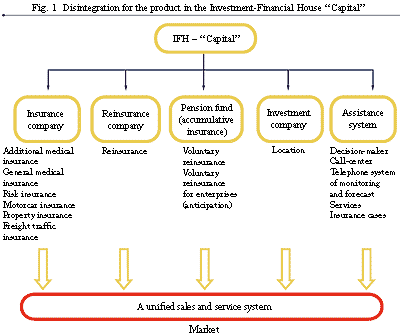
Disintegration for the product. The Investment-Financial House "Capital", the former LUKOIL insurance company has a general structure shown in Fig. 1. There is an individual insurance company engaged in voluntary or compulsory risk, motorcar and other types of insurance This is an exceptionally insurance company which can be a separate legal entity. But it may not be part of the system but be a contractor (outsourcing!). Next come a reinsurance company, a retirement fund engaged in retirement insurance, an investment which accumulated the funds for investment in various financial instruments so that it may become more profitable. There is a separate system of assistance (support): a call center where the customers are serviced and which operated for all the divisions. Everything is arranged as a "single window". That is, the customer, when he comes to the IFH "Capital", is served by single manager irrespective of what product he needs. In case outsourcing is used, a certain set of operations remains within the company, while others will be outsourced to third party contractors. . Clearly, the volume of services of the Company can be expanded by attracting third-party contractors, e.g., auction houses, for investment of the funds of the customer in works of art or antiques. And conversely, all the business system components may be disintegrated, for instance, the sales system (broker) will remain, and the rest may exist in the form of individual economic entities associated by a system of agreements and obligations.
Disintegration in terms of activity. The famous chain "The 7th Continent " in Moscow has about 50 supermarkets and grocery stores. Actually, it is disintegrated into three individual components. The OJSC "The 7th Continent" is a trade operator, which employs personnel, purchases goods, distributes them and sells. The CJSC "The 7th C Invest Holding", which manages the brand, is engaged in the advertising campaign, promotion, search for new outlet sites, solving strategic problems and the OJSC "City Gastronoms" creates new stores and solves lease problems, is engaged in construction and organization of the entire engineering equipment, etc. In this case, one can confine himself to a single activity (CJSC "The 7th C Invest Holdingг"). All other things can be done by anybody — it is not necessary that those companies should be part of your business systems.
Technology disintegration. The Moscow Region company OJSC "…energo", whose operation is associated with the manufacture of the so-called heat-exchangers and fittings for municipal heat supply systems. Still recently it has great problems with production process stability. The competition environment was harsh enough, and it was unclear what to do. They decided to manufacture and sell single-type machine complexes. This is associated with the fact that heat units are unified. Whereas formerly, when the customer came to the company he would buy the cheapest things and would come where these things were the cheapest, but after the decision was made to manufacture ready-made machine complexes, the situation changed in five to six months. The company turnovers increased by 3.5 times. The customer no longer has to think of anything: he came and bought a complete certified set with a warranty and has it assembled. The business somewhat changed on the basis of such a machine set. While previously it was single company, after the changes a repair-mechanical plant was created, the shops were granted the status of legal entities – branches with a possibility of working for the market independently. Only the flows of commodities and materials were controlled and their economy. Largely engaged in he distribution and sales of designs and machine complexes and also an assembly plant was organized, which for the manufacture of products ordered spare parts to the forging and press plant and repair-mechanical plant. Thus, the assembly plant could sell machine sets at the market as new products, but could purchase equipment for them anywhere. Each of the other two plants likewise could sell something at the market, competing with other suppliers the.
Suppose the system has not other central sales company, but the firm can operate if they find a distributor. Suppose that the forging and press plant is absent, however, the company will be workable all the same as there are numerous forging and press plants in Russia. The same applies to the repair and mechanical plant. What the company cannot do without is the assembly plant because machine set are its key business, which cannot be handed over to anyone. The rest can be readily outsourced, sold, handed over, merely destroyed or the results may be bought on the side, etc. Territorial disintegration. A characteristic example is material (mining and smelting and oil and gas) companies, constructed normally on the principle of territorial multi-industrial divisions with individual sales chains. A system like that may include processing plants and, say, within oil companies, distribution chains (filling stations).
Clearly, every territorial division is a self-sustainable business unit, which can be distinguished into an independent economic entity to be regarded as an outsourcing unit.
Industrial disintegration. This approach is new to the post-Soviet space being based on distinguishing an independent economic entities as based on the industry. An area-distributed multi-industry material company can exemplify the principles of such an approach.
The entire company falls into units of two classes: industry complexes and professional service. What is the difference and why is this division?
Industrial complexes – those are production industries, including the sales complex, which can render production processing services and equipping the same sets, whereas the professional services are non-production sectors.
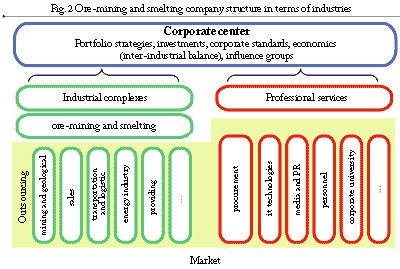
The key feature in the above example is the ore-mining and smelting industry, being our main business. Those are our main turnover – there we make the bulk of our money. That industry competes externally, e.g., at world markets. Let us consider the other complexes from those presented in Fig. 2.
The geological and mining industrial complex (available in any extracting company) is concerned with exploration and development of new deposits. Why should we confine ourselves to some particular area? We can do exploration work throughout the world. If our geologists are doing poor exploration work, too expensive, why not invite "Schlumberger", "Halliburton" or "Petro Alliance", which are professionals in that businessе. If our geologists are better why don’t we give our markets and money to those companies?
The next item is the sales complex. The sales have been well organized, the logistic chain has been adequate, everything is all right. And we can sell somebody’s products and place extra orders. Can we operate as some whole-seller, providing something else to the customers. Sure we can. No problem.
The transportation-logistical complex. Big material companies have not only pipelines, but also vessels and ports and some have railways and airlines of their own. Can they compete in the environment? Sure they can.
Fuel and energy industry. Not only UES Russa has energy assets — both generation, transmitting and dispatching. Can big material companies compete at the market of generation and transmission of electric power? Without any problem.
Energy industry. Not only RAO UES of Russia has energy assets — both generating, transmitting and dispatching. Can big material companies compete at the market of generation and transmission of electric power? Without any doubt.
The most important thing is not to determine what we are doing. The most important thing is to determine what we are not doing…
Jack Trout
The supporting multi-industrial complex is a special thing. Various minor industries should be transferred. The thing is that the biggest companies normally produce thousands of minor items and services for their own needs. Take the hotel recreational industry alone, which in addition to some social function, can earn the money for the company on the side. Involving Why not? There are capacities and resources available. Under a multi-functional supporting complex, work should be done on isolation of such minor industries of products and services, involving "Jack Welch principle" – earn, compact and sell.
What are professional services? That is the same but only in service area. Those are service in non-production industries.
Procurement. It is quite understandable that the company purchases products throughout entire Russia, Ukraine or anywhere else. Those are high-capacity systems and will for sure buy whatever is needed. Is it a service? Yes. A service that would cost cheaper to a customer than his own purchases due to the scale effect. Can we render it to third-party customers ? Without any doubt.
Information technologies. There are, of course, some commercial details, which are not to be shown to anybody, and they appear to restrict the possibility of IT outsourcing. But there is no restriction to the isolation of that industry into a strictly-controlled subsidiary, rendering professional services to third-party customers.
Media and PR. An example is found in the corporate magazine "Norilsk Nickel", which this year has become the best in world, having won the competition conducted in the Unites States. The producers of the best corporate magazine can make such a magazine for any other company.
Personnel and social area. The majority of material companies of Russia have been operating in conformity with the social responsibility standards that they set themselves. In most cases, raw material industry is hard and dirty labor under harsh climate conditions. Hence, the companies are to remain socially responsible. The work of human resources specialists and social policy is to have two components as follows: general corporate standards and professional services. The general corporate standards are set and controlled for all the company divisions. The professional services as search for, selection and assessment of the personnel, development of motivation system, refreshment and training (corporate university), etc. can be quite easily isolated from the company and can compete, operating in the external environment.
All the other activities (branches) of any big company are to be considered from the perspective of their competitiveness at an open market. In this case all the business branches except the main can be outsourced. If they can work at the market, let them earn money. If they can’t let them sell themselves or liquidate themselves. And those services, those goods we start buying on the side. The situation is very harsh and not surely all will like it. It won’t be liked primarily functional drifters and red directors. But those are their problems. Companies are not social security institutions. They are established to earn money rather than providing jobs for professional loafers producing a product that nobody needs. It is only market that can assess how necessary their activity is.
Outsourcing models
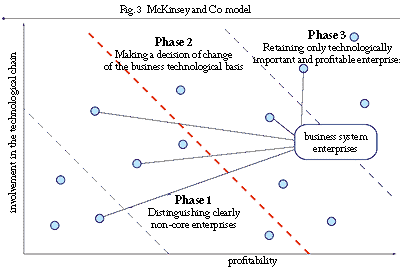
As was demonstrated all companies are a set of business units virtually ready for outsourcing. The problem is the feasibility of such operations and the applicability of the model. One of the best models is that by McKinsey (Fig. 3). Its essence is that there are two coordinate axes in some field. Axis Х reflects involvement in the technological chains (the extent of involvement is estimated by experts) and axis Y – profitability (estimated as based on nest costs and contribution to the company profit). The points on that axis are our business units and our divisions.
There are three main phases of outsourcing business units.
Phase 1. Distinguishing clearly non-core of unprofitable enterprises. Whatever is found in the lower left-hand corner of model graph is to be sold or liquidated. If those are services or products actually needed by the business they should be purchased at the market. Why? Because the profitability of such enterprises is low and they virtually are not involved in the technological chain.
Phase 2. This phase is by far more complicated as a decision is to be taken of the possible change of the business technological basis. Why is it necessary to take a decision and consider the technological properties of the business? Because something may find itself in the area of high involvement in the technological chain and that renders business dependent on such enterprises. They are losing but their technologies are very important to business. It is necessary to consider their technological aspects and, presumably, change something.
Phase 3. Retaining only technologically important and profitable enterprises. It is desirable to retain only what is actually of great importance to business and yields actual income. An exclusion from the technological chain is fatal.
This model is good, however it has a substantial drawback. In addition, to the involvement in the technological chain there are other aspects which make companies retain some enterprises. We shall discuss it below.
Outsourcing matrix
The "outsourcing matrix" is an instrument, which in a simple manner offers some principle solutions for non-core assets to be removed from the business system. I created that tool in 1999, considering the infrastructure of the company in which I worked at that time.
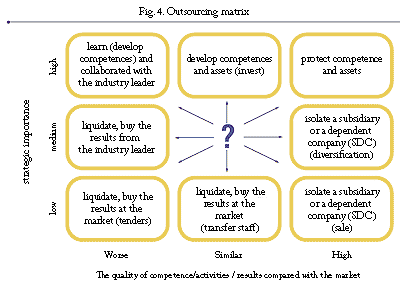
"The outsourcing matrix" is a method for distributing through the main matrix of 3×3 items concerned, which may be both a particular industry, a division, and a type of activity up to a particular specialist, a competence carrier. The central square (Fig. 4) has a particular function – in case in the analysis of the item concerned you get into it, it means that your analysis is not correct. There are not two similar competences, activities, technologies, results, companies, markets, markets, etc., available in the world. There is always a difference, and since you find yourself in the center of the matrix, it follows that you do not have enough information for analysis, The distribution follows two main scales — "strategic importance" and the scale of the correspondence of the item concerned to the mean-market condition. The distinguishing of those two analysis parameters has a fairly voluminous macroeconomic substantiation and, hence, cannot be considered in this paper, which is information-applied. In terms of the applied "outsourcing matrix" it is sufficient to answer the question how hard will be the consequences of an immediate exclusion of subject/object of analysis from the business system with respect of the strategic importance scale, and to what extent does the analysis object/subject is a monopolist for the result produced in terms of the usual enterprise markets for the scale and compared with the market. The answers to those two simple questions will provide a basis for the location of the item concerned in the competence of business operation compared with the market. There are two axes: the strategic importance and the quality of business activities against the market. The idea is simple. If the strategic importance is high, but business is non-competitive at the market (the quality of our products and services is worse than those at the market), competences are to be developed. The company is to study so the quality of its products or services increased. If the competence is roughly similar to that at the market and the strategic importance is retained, it is necessary to develop the assets and the technological base. It is required so that business should develop at the expense of investment and retaining the high strategic importance we could acquire a dominant status at the market. When some activity is important and the company can do it better than others it is the most valuable source of earning. Here the main task is to not to let anyone attack it in any way. The three squares with low competence and low strategic importance are to be liquidated, and the products and services required are to be purchased at the market.
The other two squares of the matrix show the areas where the activity is competitive at the market but is of no strategic importance to the business as a whole. (For instance, the manufacture of rubber boots from oil industry wastes some place in Kogalym. The boots are expensive, but considering the cost of delivery from the "big land", they are quite competitive at the local market. A subsidiary or dependent monopolist enterprise should be distinguished to skim the cream from the market until there a competitor or a substitute product appear or the need for boots is no longer in place. That becomes a basis for the diversification of business. As soon as some definite trends of the activity, production of function are distinguished they also become an independent business if strategically important. Some situations occur where the company is very good at something but it does not need that product or service as their strategic importance is very low. Then it is to be isolated to be sold to those for whom that is a core business. Presumably, the company will later buy those services which may be somewhat more expensive but of high quality.
The strategic importance and quality of the competences\products\results compared with the market are fairly complicated parameters. Their definition is based on expert assessment, and it is impossible to present them in figures. The strategic importance has constituents of its own.
The claims by the owner. What McKinsey model lacks. If the owner wants to do some business this is enough for the existence of that business. In the final analysis this is his company and his money. If he wants so let him be ruined.
Technological involvement. Everything depends on the company activity. For instance, what will happen if IT-network is turned off in any company? What will happen to the company? Nothing serious. The clerks will use disks and hardcopy carriers.
Profitability factor. There are some trends in the activity that ensure profitability in our work. Those are key trends in our activity. Hence, profitability as a strategic factor can exist and affect the expert assessment.
The socio-economic and political aspects of ownership. There are companies operating in difficult labor conditions liquidating its with a very harsh state regulation and high social responsibility. But sometimes despite the fact that some division or an enterprise is needless, it can be liquidated or closed down. This social responsibility is pressing and the company sometimes cannot undertake physically any measures to stop its activity. Some special programs are to be prepared to remove the enterprise from the business system. They are not ready so far, and strategically the importance of such facilities is sufficiently high.
The horizontal scale of the outsourcing matrix reflects the quality of the competence/results / products against the market.
First, it should realized that the company is producing what they buy from it. It is very important to know that they buy a value from the company. The respective product and service are only carriers of that value which is bought because the same value can be purchased in the form of various products and various services.
Secondly, it is important to know what competence the business has and to know who is doing what? Sometimes, a single person is responsible for an entire activity area, and when he is leaving everything collapses. Hence, it is necessary to analyze the actual competence of the personnel.
Thirdly, the competitive environment is to be analyzed. And, it should be analyzed whether there are competitors and who they are. Thirdly, it should be understood whether there are competitors and who they are.
Fourthly, infrastructure is to be gently turned to. It is necessary to consider the company against the market, to assess precisely whether there are structural opportunities for changing the form of property and exclusion of some elements from business. Do the market conditions allow transformation?
In order to demonstrate the effectiveness and usefulness of the application of outsourcing matrix let me tell you the following story. This is a story about technological progress and gas stoves.
One super-secret plant manufactured domestic electric stoves as auxiliary products. They are the cheapest and the simplest. Since the 1960s they could be seen at the kitchens of the recently commissioned apartments. The batch manufacture of such stoves was launched back in the 1970s, and the plant shipped them in thousands, the apartment builders valued them for their simplicity and cheapness. In contrast, the users were not very enthusiastic about those products, replacing them by more advance models at the first possible opportunity.
Once the chief engineer of the plant, who visited an exhibition of domestic appliances, paid attention to an Italian stove, which looked excellent, had various grilles, booster lights timers and other gadgets. Compared with the plant products, the Italian stove looked like a spacecraft near a lame and blind jade harnessed to a village cart.
At the nearest conference, the chief engineer claimed that it would not be worth while for the industry leader — and in fact the plant was a leader in the industry of batch production of electric stoves — to manufacture hardware, which the consumers reject at the first possible opportunity: it is inconvenient and the design is poor, it being a products of the last century. Hence, the plant is to develop and start the manufacture of a new model of domestic stove, using the Italian model as a sample, which was purchased directly at the exhibition and delivered to the chief engineer office.
So they did. The Italian wonder stove was taken to parts, the parts and technologies were designed, the suppliers defined, the personnel trained. Experimental samples were developed, and the production line was being prepared – and the chief engineer presented the new model to the management. There was much enthusiasm and pride of the new product.
It looked really fine – modern design and numerous gadgets — the local engineers used their talent an experience of their wives to improve the functionality of the stove. The precision, modern methods and colors, reliability as determined by the acceptance commission, the electric baking oven, convector and grille, gas burners, electronic appliances, thermostats and timers, intellectual computer control. So it was much better than the Italian counterpart and the industrial capacity used was great. So there was no doubt that we shall get the market and there will be a return on investment — it was a real technology wonder! It might well be exported — so classy and cheap, just super and we'll get the upper-hand of everybody!
The euphoria lasted half a year – until the attempts to sell the product continued. Then sobriety and hangover came. The stove would not sell. The efforts of salesmen traveling around the country were useless. Only a dozen of stoves were sold. The finished goods warehouse was crammed with stoves. Some products were kept in an open air, and no urgent price reduction or convulsive advertising campaign attracted buyers. The stove would not sell. True enough, except in the cottages and apartments of the "new Russians", where could one find a kitchen with a gas and electric entry service concurrently. And where it does exist, they prefer imported makes, which can be purchased virtually elsewhere, both in Moscow and in a back country.
Incidentally, the 1970s line manufacturing the old stoves was handed over to a component manufacturer, for he pleaded for help. By that time the component manufacturer had developed the manufacture of a slightly modified old stove for mass equipment of the new apartments. It still continues to be shipped in batches. The result is the money lost on the development of new products, technological capacities and competences, ensuring the leadership of the enterprise. If one takes a look at the matrix for those products one can see the following situation.
With the old electric stove, the plant was virtually a monopolist. Despite its obsolescence and simplicity, the builders purchased such stoves as they had to equip new apartments. And the cheaper the better. With production of new stoves, the plant changed the market segment. While previously it operated in the segment of mass apartment construction, being a monopoly supplier of the equipment, with the release of new stoves, it entered a highly-competitive segment, where the consumer preferences are determined not by the prices but rather but the make of the product, i.e., the brand. The plant needed to isolate the manufacture of cheap stoves into an independent division and slim the cream from that market as it was a virtual monopolist in that industry. In this case, there was no acute need for modification of the existing line — may be for merely capturing the entire market of mass construction. But that would have been a business unit rather than the plant.
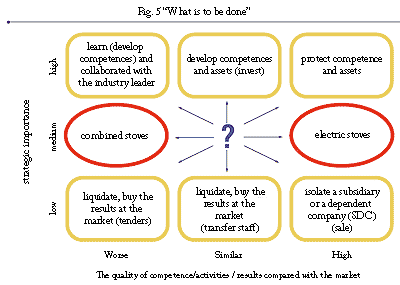
Due to transition to the manufacture of new stoves, the plant stopped and disintegrated the production, it being not the main. Balance depot stocks were sold to the employees, and installed in the own cottage village — some modification was required and a three-phase entry service had to be installed. Also social enterprises as kindergartens, day care centers, sanitariums, etc. were equipped with those stoves.

As based on the "outsourcing matrix" (figs. 5, 6), as far as the new stoves are concerned the plant should augmented the value of its products having made an agreement or having established a joint venture with the foreign manufacturer – the brand carrier and marketed its products undеr his name or with the mention of his name through a chain of product promotion. The main production has allowed such actions until the plant developed a market proposal (name, price, recognition, characteristic features, etc.),acceptable by the consumer.
Properly speaking "the outsourcing matrix" permits assessing the design of the chief engineer. His main idea is development of the assets and competences (the green arrow in Fig. 7). Concurrently, he proposed handing over the obsolete production to an allied supplier (the yellow arrow). However, a serious error was made — the enterprise changed the segment for the one where its products proved non-competitive (at least, from the perspective of the consumer). That transition is marked with a red dashed line.
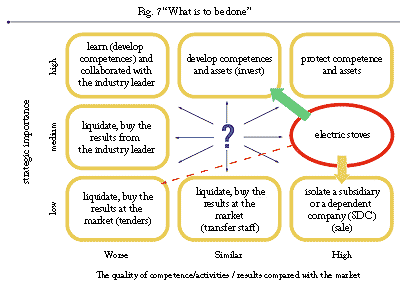
As a result, having shifted to the part of the market where the plant products the plant had the quality of competences and the products lower than those in the competitors, the enterprise suffered a strategic defeat — in fact, the funds were lost and the business, if not the most important but yielding sustainable profits was liquidated.
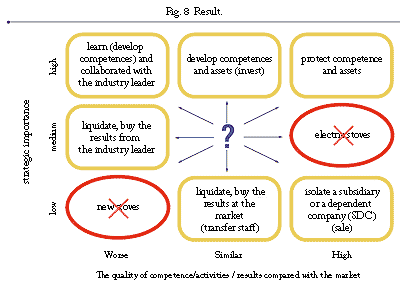
Thus, it can be concluded that an erroneous business system configuration brings about new ineffective projects and is detrimental to the main business. A simple and understandable tool "outsourcing matrix" permits the entrepreneurs to assess the consequences of strategic solutions in terms of configurations and infrastructure of business systems and not to make mistakes, which in contrast to the story might be fatal for the enterprise.
Tags: Outsourcing matrix, Outsourcing of office printing
 Print version
Print version